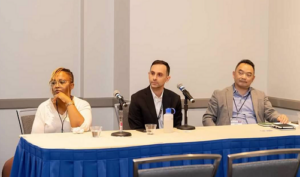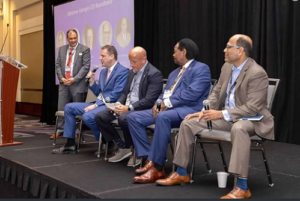 By Beth Friedman, Sr. Partner, FINN Partners
By Beth Friedman, Sr. Partner, FINN Partners
LinkedIn: Beth Friedman
LinkedIn: FINN Partners
HIMSS Chapter conferences often bring together some of the most unexpected and interesting people. This month’s Georgia HIMSS 2024 Annual Conference was no exception. I attended the event expecting to hear the usual conversations around AI, EHRs and security.
Those topics were certainly covered. However, the event also held a few surprises including football helmets and a suspicious stalker.
I arrived late (if you live in Atlanta you know). I was met by a security guard for the conference center who informed me that the building was on lock down due to a suspicious person on the premises. He escorted me in and then secured the door behind me. Nothing materialized from the lockdown, and everyone was safe. Did I mention there is never a dull day in Atlanta?
After saying hello to my Healthcare NOW Radio colleagues Roberta Mullin and Justin Barnes, I sat down for an intriguing keynote presentation by Dr. Gregory Stewart, Co-Founder and Co-Director of the Center for Sport of Tulane University. Dr. Stewart proceeded to explain the important connection between NFL players and health information technology.
Unexpected Intersections: NFL and Health Information
I thought I knew about professional football and player injuries, but I was wrong. In 2016, I met Dr. Bennet Omalu at a national American Health Information Management Association (AHIMA) conference in Baltimore, Maryland many years ago. Dr. Omalu is the forensic neuropathologist that discovered and named Chronic Traumatic Encephalopathy [CTE] in football players, wrestlers and military veterans.
With Dr. Omalu’s conversation as my background, I was presently surprised to see how far the NFL has come since Concussion was released in 2015. Here are four steps Dr. Stewart shared about the NFL’s efforts to protect and prevent player injuries.
- Helmet safety has been researched for over a decade with annual reports listing each manufacturer’s performance across a four-tier ranking system. The annual helmet laboratory testing performance results demonstrate which helmets are safe and which aren’t.
- Data sensor technology is now incorporated into everything from rings to shoulder pads and mouthguards.
- Near real-time data is captured and aggregated in the AWS cloud to analyze data by player, by stadium (turf vs. grass), and much more.
- Artificial intelligence technology (including employment of international AI engineers) is used to predict which players are nearing fatigue or may incur injury.
Healthcare now has the responsibility to curate, manage, analyze, and protect massive patient data sets. And so does the NFL. Player health data must remain private and protected. Dr. Stewart was joined on stage by two former NFL players: Ovie Mughelli and Byron Scott to discuss health information from the players’ perspective.
The players reiterated Dr. Stewart’s concerns regarding injury prevention and health information privacy. Our two industries are worlds apart. However, data, analytics, AI, privacy, and health information are common threads.
From the Field to the Floor: Advice from the Frontlines of IT Transformation
 Another valuable session shared success stories and best-practice advice for optimizing value through IT transformation. Panelists included speakers from AHIMA, Wellstar and Emory Healthcare. The following insights were shared and discussed.
Another valuable session shared success stories and best-practice advice for optimizing value through IT transformation. Panelists included speakers from AHIMA, Wellstar and Emory Healthcare. The following insights were shared and discussed.
- Share the “why” for every new technology initiative.
- Include end users and make teams part of the change.
- Start with pilot projects. Assess outcomes before extending to other sites.
- Use an agile methodology and shed technologies that don’t work in the pilot phase.
- Respect and acknowledge the impact your new technology will have on the workforce.
GA HIMSS CIO Panel Never Disappoints
The GA HIMSS 2024 Annual Conference concluded with a valuable panel of leading CIOs from Georgia hospitals and health systems. This year’s lineup included IT executives from Northeast Georgia Health System, Emory Healthcare, Piedmont Healthcare, The Shepherd Center, and St. Joseph’s/Candler in Savannah. The panel engaged in insightful discussions on how healthcare technology is evolving to meet operational, clinical, and patient care challenges.
Geoffrey Brown, VP and CIO from Piedmont Healthcare emphasized the energy and progress made in interoperability, and the financial and revenue cycle side of healthcare. He underscored the importance of reducing the workload on clinicians and staff by using automation to streamline tasks and improve efficiency.
Atul Kanvinde, CIO of Shepherd Center, focused on the human-centered design of technology. He stressed that while technology is critical, the real challenge is determining how to implement it effectively. He highlighted the use of smart rooms at Shepherd, which cater to patients with limited mobility, demonstrating how tailored solutions can improve patient progress, independence and outcomes.
Nolan Hennessee, CIO/VP of St. Joseph’s/Candler in Savannah pointed out the challenges of community access to care, particularly in scheduling appointments with specialists. He emphasized AI’s growing role in offering patients more care options when appointments are unavailable, such as virtual visits and alternative locations for procedures like MRIs.
Dr. Alistair Erskine, Chief Information and Digital Officer at Emory Healthcare spoke about the potential of ambient listening tools for clinicians and the growing use of video technology in hospitals to enhance patient safety. He also mentioned Emory’s Digital Academy, which helps upskill IT teams and healthcare professionals in leveraging technology.
Finally, Chris Paravate, CIO of Northeast Georgia Health System closed by reminding the audience that core healthcare technology is essential but evolving quickly. CIOs must adopt a growth mindset to remain agile and continuously improve care delivery through innovation.
